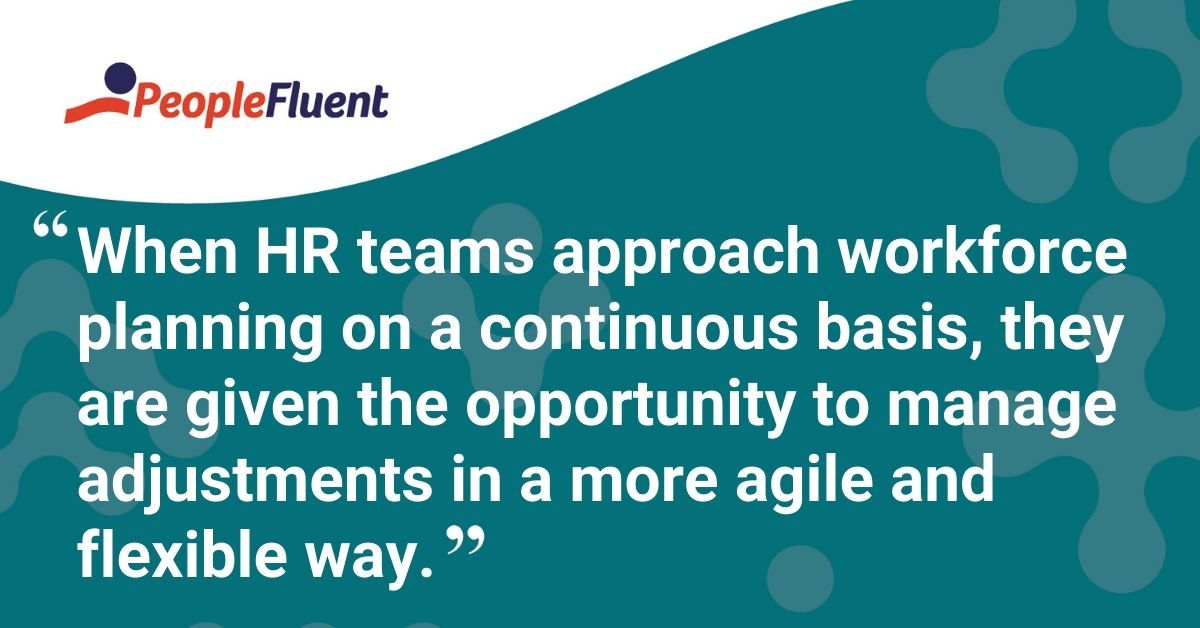Published: Jul 20, 2020Time to read: 5mins Category: Org Charting
How to Ensure Your Workforce Planning Is Predictive and Continuous
Table of Contents
In today’s ever-changing climate, workforce planning should be a continuous and predictive process. However, most companies are stuck planning around an annual budget cycle instead of taking a holistic view of their organizational shifts. When the need arises to fill more or fewer positions than originally planned, HR leaders must remain flexible and agile to manage these adjustments while staying within budget.
The truth is, HR teams must work within a framework that reflects the realities of your teams to avoid workarounds that can increase costs and lower productivity. Workforce planning connects all facets of talent management by identifying skill gaps, targeting the right candidates for open positions and succession, and determining the right departmental relationships that drive productivity.
With organizational charting, companies get a comprehensive, bird’s-eye view of the organization and can readily pinpoint internal pathways and journeys for employee growth. This article identifies and outlines the challenges HR teams face with predicting and adjusting workforce plans to optimize employee performance and overall productivity.
How Often Should Workforce Planning Occur?
Workforce planning should be a continuous process, although most companies won’t focus on it until it’s time to plan an annual budget cycle. Proactive workforce planning is critical to ensure leaders have the most up-to-date and significant insights on the economic impact of various scenarios such as:
- company mergers
- division sell-offs
- acquisitions
- office openings and closures
- workforce reduction
- product launches/expansions.
When HR teams approach workforce planning on a continuous basis, they’re given the opportunity to manage adjustments in a more agile and flexible way. Of course, this type of visibility requires the necessary automation to ensure an open and transparent pipeline of information and updates as they’re made, like an employee entering or leaving the company and how teams may be impacted by such a change.

MORE FROM THE BLOG: '4 Headcount Planning Strategies to Drive Success'
Current Challenges Facing HR Teams
Before COVID-19 caused organizations to rearrange their priorities, workforce planning was often seen as a chore for HR professionals, one that was seldom completed and which didn’t have enough visibility into the organization’s many moving parts to make appropriate changes.
Now, this type of planning may occur almost weekly as new information regarding domestic and global lockdown continues to shift. With workers becoming shared resources between divisions, departments and teams, and remote work a necessity to ensure safety and business continuity, your HR team may be overwhelmed or uncertain about the best approach to managing adjustments.
Without the use of updated and complete data, workforce planning was a disjointed process that discouraged HR teams to plan as often as necessary. Scrubbing data or chasing down information across departments created a new headache for HR professionals by bogging them down with extraneous administrative tasks.
Many of these challenges surrounding workforce planning were due to manual tasks, such as managing the organizational changes via spreadsheets, and a lack of visibility into the total workforce. This is why automated solutions are necessary to ensure greater visibility across the organization, with the most complete and relevant information possible.
Lastly, organizations are no longer considering physical location to be a determining factor when making hiring decisions. In fact, remote job listings via LinkedIn have been surging since the beginning of March 2020. Securing top talent, from anywhere in the world, has taken precedence over a candidate’s proximity or ability to work from a physical office.
Optimize Your Workforce Planning
In order to make the shift to a more predictive, continuous approach, it’s necessary to audit your organization’s workforce. HR teams can effectively optimize your workforce planning in a more proactive way by considering the following:
- Know who is in the organization and what regions, time zones, etc. they’re located in
- Identify and track office equipment
- Build internal communication chains for emergencies
- Understand the span of control as roles and responsibilities change
- Visualize the composition of the workforce (full- and part-time roles as well as contingent labor)
- See gaps caused by layoffs, furloughs, or other organizational changes
- Know the financial impact split by organizational divisions, groups, or regions.

KEEP READING: 'Visualizing Analytics: The Answer to Workforce Planning'
Planning for various scenarios and shifts can be led by HR, but executive stakeholders and management teams should also be involved in the process. This ensures greater visibility into potential issues that may arise on individual teams throughout the organization, such as upcoming maternity leave or succession goals that may not otherwise be known by executive leadership.
Identifying and understanding how to fill workforce gaps will be an especially critical function as people come back to work and managers look to reorganize their hiring and succession goals.
Ready to develop a predictive and continuous approach to workforce planning? Download the OrgPublisher product sheet to see how PeopleFluent can provide the visibility necessary for successful workforce planning.
Discover How Org Charting Helps You See Your Enterprise in New Ways
An organizational chart can be more than something to look at. It can tell you things. See and understand your workforce in real time and living color.